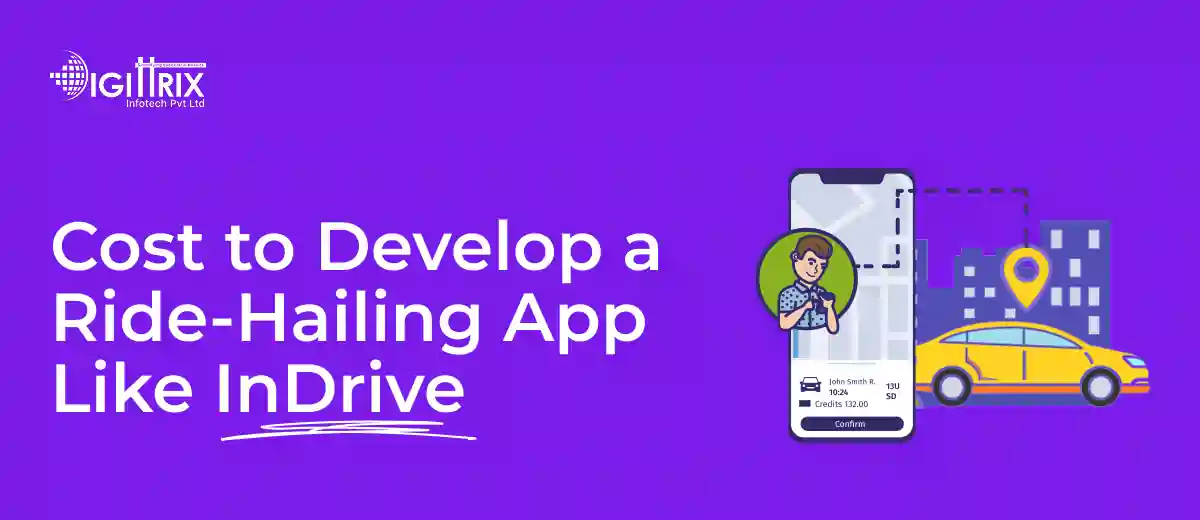The global ride-sharing app market is expected to surpass $185 billion by 2026, driving up demand for affordable InDrive-like app solutions worldwide.
Highlights
An enthusiastic developer and skilled business management expert with over a decade of experience in the field

Ride-sharing apps have become a regular part of life for many Australians looking for convenient and private ways to travel. Recently, the development of these apps has increased in popularity as more cities and riders adopt this model. If you're planning to create an app like InDrive, this guide will outline the costs involved, giving you a clear idea of what to expect for a successful launch in 2025.
InDrive is a taxi booking app development platform that allows passengers to propose fares, and drivers can accept or counter them. It also supports carpooling app development, enabling multiple riders to share a trip. The model differs from traditional ride-hail apps by giving fare control to users. If you're planning to develop an app like InDrive, you’ll need to include both standard ride-hail features and this bid-fare system.
Curious about ride-sharing trends? Check out the ultimate 2025 guide to the best ride‑sharing apps offering features, comparisons, and top picks for modern commuters.
To estimate costs, let's break down the essential components. A well‑built system generally includes the following:
Conducting market research, competitor analysis, planning core features, and preparing technical documentation.
This is part of the planning stages for carpooling and taxi booking app development.
Clear design for riders and drivers, covering initial onboarding, fare proposal screens, maps, and admin functions.
This is essential for any Ride Sharing App Development project.
This covers databases, servers, API integration, bid logic, push notifications, and analytics.
Testing for usability, cross-device issues, mapping accuracy, bid logic, and edge cases.
Includes app store submission, GDPR or local legal compliance, server setup, and launch strategy.
You’ll need continued updates, server maintenance, bug fixes, and monitoring.
The total investment for building an app like InDrive in 2025 typically ranges between:
USD 80,000 – USD 300,000 (INR 68,00,000 – INR 2,55,00,000)
Breakdown:
Development rates vary: India/Eastern Europe ($25–$50/hr), US/Western Europe ($100–$200/hr).
The bid‑fare (InDrive‑style) introduces additional complexity. Advanced map features like route optimisation, pool matching, and surge‑style logic raise costs.
Native development is more costly than cross-platform options like Flutter or React Native. Using more advanced databases, dedicated servers, or redundancy also boosts expenses.
Data privacy laws (e.g., GDPR) and city taxi regulations can be expensive to enforce.
Scaling servers, monitoring, driver/rider support, and marketing require ongoing funding.
Launch with essential features only: a simple app for riders, drivers, a map, basic bidding, and payments. Skip extras like multiple wallet options or advanced analytics. Focus on validating market demand before adding more features.
Tools like React Native and Flutter can cut down mobile development time. Rider and driver apps share code.
Hiring teams in Eastern Europe, Latin America, or India can be cost-effective without compromising quality.
Utilise existing platforms for maps, payments, notifications, and chat. Implement bid logic in your backend.
Prevent scope creep. Use agile sprints, gather feedback early, and only include what is essential.
If you intend to include carpooling app development features, the scope expands. You’ll need:
Expect an additional 10–25% cost added to the core build compared to a standard single‑ride app.
The admin portal is vital for tracking ride flow, resolving disputes, and assisting riders or drivers. Typical features:
This pertains to the taxi booking and ride-sharing app development.
Connecting reliable payment systems—Stripe, PayPal, or local gateways—requires security and compliance (PCI DSS). You also need:
Security investments are important. Include a cost buffer (5–10%) for audits, SSL, encryption, and regular security reviews.
Choose according to your budget, time, and quality requirements.
A realistic timeline for full launch:
Total time: 8–12 months from concept to app store availability.
Common revenue models:
With an investment of USD 150,000 INR (₹1.27 Cr), you can recover it through roughly 75,000 rides, earning a USD 2 (INR 170) commission per ride.
Post‑launch, budget for:
Aim to spend 15–25% of your initial development cost each year on maintenance.
Getting ready to seek funding? Learn “how to pitch your ride‑sharing app startup to investors” with actionable advice and investor insights.
To develop an app similar to InDrive by 2025, anticipate a total investment of USD 80,000 – USD 300,000 (INR 68,00,000 – INR 2,55,00,000). Main cost factors include your choice of development partner, location in Australia, feature complexity, and post-launch support. Add approximately 10–25% for carpooling app development features—also budget for payments, security, and legal compliance.
Beginning with an MVP, leveraging cross-platform tools, and managing scope can greatly reduce costs and accelerate development. This method offers a competitive ride-hail or taxi booking app development service with a user-driven bidding model that makes InDrive stand out.
With thoughtful planning and effective execution, your app, whether for solo rides or shared trips, can excel in experience, cost, and convenience. In 2025, meeting user expectations with a good balance of price and value is vital for success.
Looking to launch your fare-negotiation-based ride app like InDrive? With the rising demand for flexible and affordable urban travel, creating a custom ride-sharing platform is a smart move. At Digittrix, we offer complete Ride Sharing App Development and taxi booking app creation services. Whether you're starting from scratch or want an InDrive clone app, we provide both cost-effective and feature-rich solutions tailored to your business goals.
Our team creates secure, fast, and user-friendly mobile app development solutions that support unique models like fare bidding, real-time ride tracking, and carpooling. If you're wondering about the cost to build an app like InDrive in 2025, we’re here to guide you through every step, from idea to launch.
Ready to get started? Call us at +91 8727000867 or email digittrix@gmail.com for a detailed consultation and customised quote.

Do you need help in Mobile App development?




Join over 1500+ businesses we've already helped!
Beauty App Development: Tips to Grow Your Business Through an App & Cost in India (2026)
Key features include user registration, fare bidding, real-time GPS tracking, in-app messaging, payments, driver verification, and a control panel.
Yes, you can lower costs by starting with an MVP, using cross-platform tools like Flutter, and hiring developers from more affordable regions.
Building a carpooling or ride-sharing app like InDrive usually takes 8 to 12 months, including design, development, testing, and deployment.
Common stacks include Node.js or Python for backend, PostgreSQL or MongoDB for data, and Flutter or React Native for mobile app development.

©2026Digittrix Infotech Private Limited , All rights reserved.